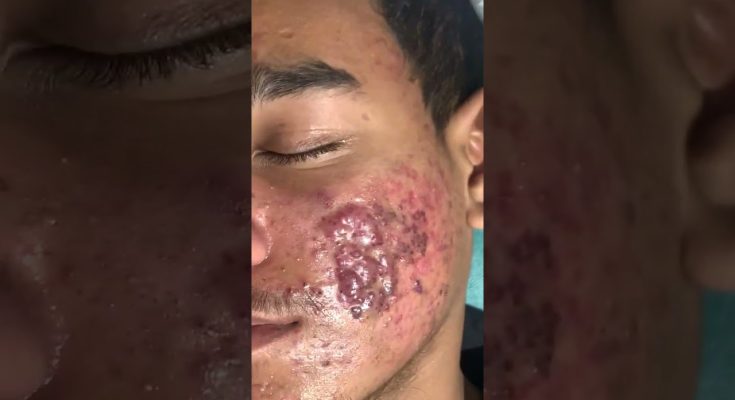Black peel treatments, often referred to as chemical peels, are a popular method for treating acne and its residual effects like scarring and hyperpigmentation. These treatments typically involve the application of a chemical solution, such as salicylic acid or trichloroacetic acid, that exfoliates the skin’s outer layer, promoting skin regeneration and revealing smoother, clearer skin beneath.
### What is a Black Peel?
A “black peel” is typically a treatment that uses a specialized formula, which includes organic acids and natural ingredients like black vinegar and salicylic acid. This particular combination targets acne, blackheads, and oily skin by deeply exfoliating the skin and promoting cell turnover. The result is a smoother skin texture, less visible acne scars, and reduced active breakouts.
Salicylic acid, a key ingredient in black peel treatments, is a beta-hydroxy acid (BHA) known for its ability to penetrate deep into pores and exfoliate the inside walls of the skin. It is particularly effective in treating oily skin, blackheads, and whiteheads by breaking down sebum and dead skin cells that clog pores.
### How Does Black Peel Treatment Work?
1. **Exfoliation**: The treatment starts by exfoliating the top layer of skin. Black peel solutions often contain salicylic acid, which gently dissolves the bonds between dead skin cells, allowing them to be shed. This not only removes the outer layer of dead skin but also promotes faster regeneration of new skin.
2. **Acne Reduction**: As the black peel removes dead skin cells and excess oil, it helps unclog pores, which is one of the main causes of acne. Unclogging the pores also prevents the formation of new pimples, blackheads, and whiteheads.
3. **Anti-Inflammatory Effects**: Salicylic acid has anti-inflammatory properties, which helps reduce the redness and swelling often associated with acne. By calming inflammation, the skin looks more even-toned and less irritated.
4. **Improvement of Acne Scars**: In severe cases of acne, scars can form as a result of tissue damage from deep, inflamed cysts or nodules. Chemical peels like the black peel can help minimize the appearance of these scars by promoting collagen production and improving skin texture over time.
### Types of Chemical Peels for Acne
1. **Superficial Peels**: These are the mildest type of chemical peels, often referred to as “lunchtime peels.” They use mild acids such as alpha-hydroxy acid (AHA) to gently exfoliate the outer layer of skin. Superficial peels are ideal for treating mild acne, clogged pores, and reducing the appearance of blackheads. Recovery time is short, and side effects are minimal.
2. **Medium Peels**: Medium-depth peels penetrate more deeply into the skin and are more effective at treating moderate acne and scarring. They usually involve glycolic or trichloroacetic acid (TCA). These peels require more downtime, as the skin typically flakes or peels for a week following treatment.
3. **Deep Peels**: Deep chemical peels are more invasive and are used to treat severe acne scars and deep wrinkles. They involve stronger acids, like phenol, and can result in more dramatic improvements. However, recovery time is significantly longer, and these peels are often done under medical supervision.
### Benefits of Black Peel Treatments for Acne
– **Effective for Oily and Acne-Prone Skin**: Black peels help control excess oil production, which is one of the leading causes of acne. By regulating sebum levels, the likelihood of clogged pores and breakouts is reduced.
– **Reduces Blackheads and Whiteheads**: The exfoliating action of the peel helps clear out blackheads and whiteheads, making the skin smoother and less congested.
– **Improves Skin Texture**: Over time, black peel treatments can refine skin texture, making it look smoother and more even. This is particularly helpful for those who have suffered from acne scarring or rough skin due to repeated breakouts.
– **Minimizes Hyperpigmentation**: The peel also helps reduce the appearance of dark spots or hyperpigmentation caused by acne, sun exposure, or other skin injuries.
– **Prevents Future Breakouts**: By keeping the pores clear of oil, dead skin, and debris, black peels can help prevent future acne breakouts from occurring.
### Possible Side Effects of Black Peel Treatment
As with any chemical peel, there are potential side effects that need to be considered before undergoing treatment:
1. **Redness and Irritation**: The skin may become red, irritated, and feel tight immediately after the treatment. This is a normal part of the healing process but can last for a few days.
2. **Peeling and Flaking**: Peeling is a common side effect as the old skin sheds and new skin takes its place. While this can be uncomfortable, it’s an essential part of the treatment process.
3. **Dryness**: The exfoliation process can leave the skin feeling dry. It’s essential to use a gentle moisturizer post-treatment to keep the skin hydrated and to avoid harsh products during the healing period.
4. **Increased Sensitivity to Sun**: Chemical peels can make the skin more sensitive to UV rays, which is why sun protection is crucial after the treatment. Failing to use sunscreen can result in hyperpigmentation or sunburn, as the skin is more vulnerable.
5. **Risk of Hyperpigmentation**: In some cases, chemical peels can cause post-inflammatory hyperpigmentation, particularly in individuals with darker skin tones. This risk can be mitigated by choosing the right type of peel for the skin type and by following post-care instructions carefully.
### Pre-Treatment Considerations
Before undergoing a black peel or any other chemical peel, it’s essential to take a few precautions to ensure the treatment’s success:
– **Consult a Dermatologist**: Not everyone is a candidate for chemical peels. People with very sensitive skin, certain medical conditions, or those taking specific medications should consult with a dermatologist to determine if a peel is suitable for them.
– **Avoid Harsh Products**: In the days leading up to a chemical peel, it’s important to avoid using any harsh exfoliants, retinoids, or other strong skincare products that could sensitize the skin.
– **Sun Protection**: Because chemical peels can make the skin more sensitive to the sun, it’s important to minimize sun exposure and use a broad-spectrum sunscreen both before and after the procedure.
### Post-Treatment Care
Proper aftercare is crucial to getting the best results from a black peel. Post-treatment care typically includes:
1. **Moisturizing**: Hydration is essential as the skin heals. A gentle, fragrance-free moisturizer should be applied regularly to soothe and protect the skin.
2. **Sun Protection**: As the skin will be more vulnerable to sun damage, it’s vital to apply a broad-spectrum SPF of at least 30 every day.
3. **Avoid Picking or Scrubbing**: It can be tempting to pick at peeling skin, but doing so can result in scarring or hyperpigmentation. It’s important to let the skin shed naturally and avoid using harsh scrubs or exfoliants during the healing process.
4. **Gentle Cleansing**: Use a mild cleanser to wash the face, avoiding any harsh or stripping products that could further irritate the skin.
5. **Avoid Makeup**: It’s recommended to avoid makeup for at least 24-48 hours after a peel to allow the skin to breathe and heal.
### Conclusion
Black peel treatments offer a powerful solution for those suffering from acne, oily skin, and blackheads. By combining the exfoliating power of salicylic acid with natural ingredients, this treatment can help clear acne, reduce scarring, and improve overall skin texture. However, as with any chemical peel, it’s essential to consult a professional and follow post-treatment care guidelines to minimize risks and maximize results. By taking these steps, individuals can achieve smoother, clearer, and more radiant skin.

